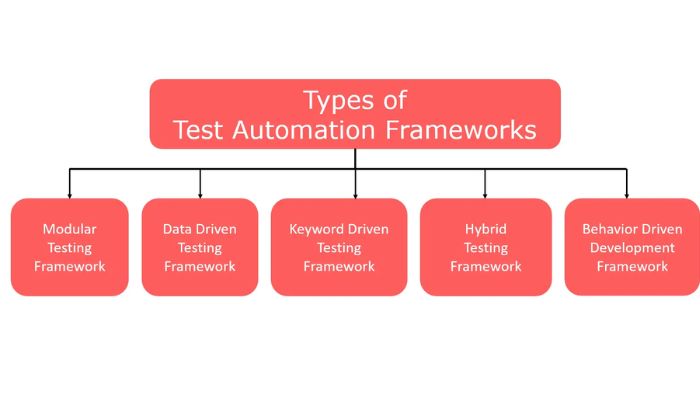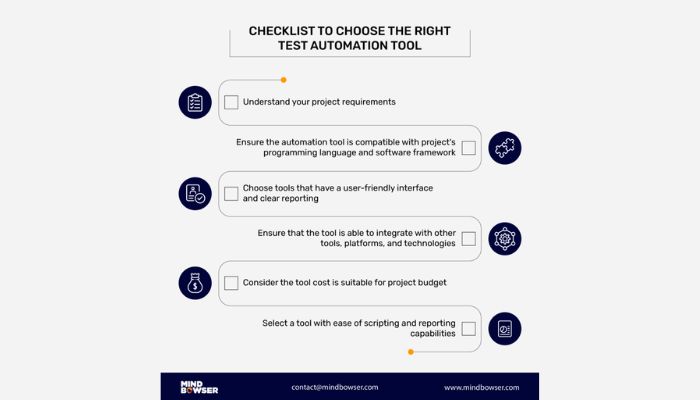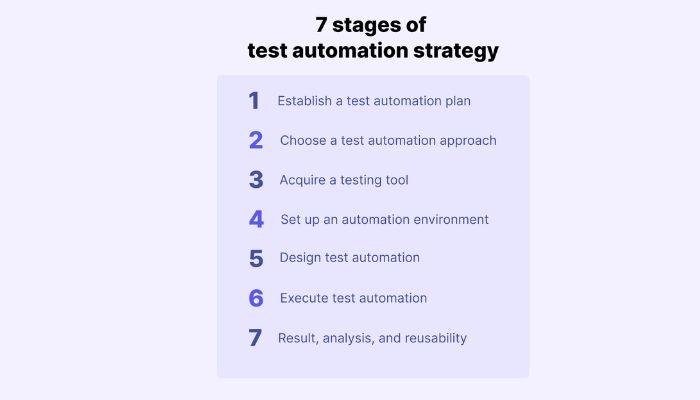Test automation frameworks provide a set of features and best practices designed to help build efficient, effective test automation systems.
By providing automated solutions for frequently repeated or tedious tasks, these frameworks cut down on test development time while enabling teams to validate software more thoroughly.
In this guide, we’ll explore what test automation frameworks are, the different types available and how to select the right one for your project.
We’ll discuss some best practices you should keep in mind when creating your framework and common challenges that may arise along the way. Finally, we will recap essential points about using an Automation Framework in your system testing processes.
Types of Test Automation Frameworks

Modular Frameworks
Modular frameworks are test automation designs that decompose applications into discrete modules which represent business functions. This allows QA activities to move from one module to another and thus increases the reusability of tests across multiple areas of functionality.
Additionally, by using automation techniques like object mapping and object identification, modular frameworks help reduce maintenance costs when an application changes or updates since the same modules can be used with slight modifications.
It also helps eliminate redundant code such as test steps that are repetitive in nature existing. With these advantages, you will get comprehensive coverage for your applications being tested while seeing a decrease in time cost for personnel and executing faster testing automation each iteration.
Keyword-Driven Frameworks
Keyword-Driven Frameworks are used to develop automated tests using keywords or terms that map to different functions. Tests are written to utilize reusable actions, such as login and logout, along with control flow organization which steps the user through the independent tests built from these keywords.
The advantages of this system include structure, maintainability, and traceability making it easy for multiple staff to collaborate on test writing together.
Additionally, new frameworks can be easily added depending on changes within your application’s functionality while at the same time slowing down longer execution times due one not having pure libraries but instead defining actions in a slower manner and using necessary data fields more often.
Limitations however come from initial setup costs due to pipeline creation before being able to solve any test cases. An additional issue with the framework arises if complex decision trees and object identification occur since this framework relies largely on keywords which can be limited in functionality for an expected result.
Data-Driven Frameworks
Data-driven testing breaks down data into separate input and expected output values, allowing developers to perform automated tests taking these parameterized test cases.
This results in faster creation and execution of tests with minimal iteration needed per individual test, as well as a higher degree of accuracy estimated during the automation process.
By using appropriate external data storage (like MySQL) or provision for feedback loops to result from each set executed, implementation can further be optimized by being able to note trends surrounding specific server behaviors across all consoles used or pinpoint differences in tester approaches overall.
Additionally, parameters are not hard coded when executing iterations, enabling more precise localization control based on each unique environment tested – enabling the testers who are carrying out the automation to better be able to recognize and solve any raised issues quicker.
Hybrid Frameworks
Hybrid test automation frameworks combine components of modular, keyword-driven, and data-driven testing frameworks. The intention is to establish a robust framework that provides better reusability, maintenance, and scalability advantages compared to the standard approaches for software testing automation.
Hybrid frameworks can help address challenges in source code reuse because they utilize features from both Keyword Driven Test Automation as well as Data Driven Test Automation.
They enable combining theoretical steps for script design with automation tools, like Selenium or other open-source tool suites.
This means achieving maximum coverage while minimizing redundancy of effort across creation and execution cycles will be a more efficient and cost-effective ideal from a testing perspective.
Choosing the Right Test Automation Framework
Factors to Consider

Project Requirements
When choosing the right test automation framework, one of the most important factors to consider is the project’s requirements. Each type of testing environment will likely have different needs: unit tests require speed and isolation; integration tests require proper setup configuration; functional requirements need complete system coverage.
The architecture and technology of the application should also be taken into account, that way a suitable automation solution can be chosen that suits specifically.
There may also be other external factors influencing choice such as licenses or specific tools required for successful implementation. Careful consideration should always been given to size, complexity as well as strategic impact when deciding upon a framework for automation.
Team Skills and Expertise
When selecting a test automation framework, it’s important to consider the skillset of any team members responsible for using the framework.
Frameworks are built with different levels of complexity so matching the currently available team skills while allowing for growth is essential.
Having both manual and automation testers working together from an initial set-up message can have a big impact in helping identify gaps where refining and tactical training may be necessary.
If certain technical knowledge or experience within customer/third-party applications are needed, researching ways to improve on this type of skill beforehand is beneficial as early as possible.
Scalability and Maintainability
When choosing a test automation framework, scalability and maintainability are important factors to consider. An ideal framework should support scaling up or down in accordance with changing project requirements and technology.
It should also have efficient debugging capabilities, for quickly resolving errors during test executions. Further, the maintainability of the framework should be taken into consideration – changes made to one script must not affect the entire suite of tests.
Proper documentation of scripts is essential so developers can easily comprehend codes over time without needing frequent elaborate tutorials.,
Best Practices for Test Automation Frameworks

Maintainable and Readable Test Scripts
One of the best practices for test automation frameworks is to create maintainable and readable test scripts. Maintainable code that has a clearly labeled structure, allows developers with similar skillset to find their way quickly without requiring them to learn complex context structures.
Readable coding also means creating self-tested objects or commenting elaborate control sections with inline explanatory comments.
Going beyond basic qualifiers viz., executable code flags like try/catch clauses can save huge efforts in troubleshooting problems, disposing of resources safely and robust error reporting with verbose messages during the process of automating long-run regression tests.
Efficient Test Data Management
Good test data management is key for successful test automation! Requirements should be evaluated when applicable to determine which type and amount of test data is necessary, as well as storage methods.
Careful planning ahead of time helps to streamline the process in order to reduce costs and development time.
Additionally, automated tools can help generate large sets of data efficiently while having variables built in that allow preset values or inputs.
Robust Error Handling and Reporting
Robust error handling and reporting are essential when it comes to test automation review. Error handling should communicate that an issue exists along with key diagnostics for debugging purposes.
It should be logged for further discussion or for developers on the team so they can investigate the errors and have a data-driven approach in case alternate solutions exist.
Additionally, error messages need to be written clearly enough that users other than the initial tester understand them while being comprehensive as possible about what action led up to the failure.
A good report should promptly provide all feedback users need to be built using patterns, such as application-wide crash analysis or slow loading metrics detection, etc.
This ensures fast response time when needed by debuggers inspecting occurrences and gives stakeholders additional information and enough evidence on matters worthy of debugging or support.
Continuous Integration and Delivery Integration
Continuous integration keeps the development and testing cycle efficient through technological infrastructure that automates such processes as build generation, compilation processes, and multimedia performance.
Additionally, by integrating with delivery automation services, packaged data can be quickly distributed to multiple users—ensuring up-to-date knowledge, updates, and bug fixes are widespread in little time.
By combining continuous integration with delivery automation all components related to applications flow efficiently through pre-defined workstreams resulting in not only increased system visibility but also better quality assurance & testing and faster deployments of new software or features.
Conclusion
Test automation frameworks are instrumental for improving the reliability and repeatability of test scripts. Various types and approaches can be selected in order to meet the needs of different projects.
When selecting the appropriate framework, it’s important to factor in project requirements, team skills, scalability & maintainability before testing & unveiling a prospective framework.
Following best practices while creating, optimizing, and executing your tests is also necessary to maximize efficiency – making sure that scripts are maintainable and readable; good test data management is in place with robust error handling and reporting capabilities, as well as those for integration with CI/CD processes, will, effectively ease future script maintenance efforts.
Utilizing well-slated Toolsets might superspeed this whole procedure…but make sure you chose something comprehensible enough for multiple members working together on your team.


















